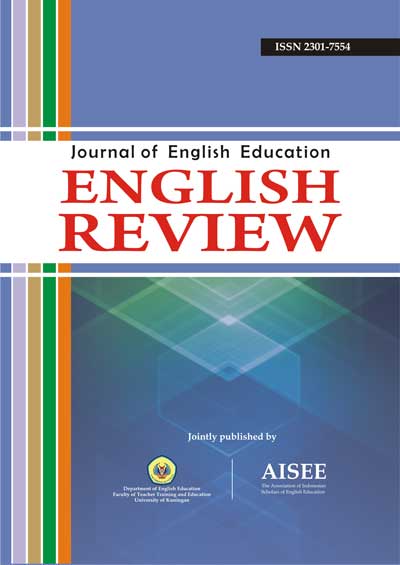THE ANALYSIS OF PRESUPPOSITION IN THE SHORT STORIES OF SILVESTER GORIDUS SUKUR
Abstract
Abstract: This paper is descriptive qualitative which describes the types of presuppositions and their meaning in the short stories by Silvester Goridus Sukur. The research questions of this paper are; What are the types of presupposition and dominant type of presupposition in the short stories by Silvester Goridus Sukur. In order to analyze the data, the writer employs Yule’s theory which divides presupposition into 6 types: existential presupposition, factive presupposition, lexical presupposition, structural presupposition, non-factive presupposition and counterfactual presupposition. The data of the research are sentences which contains presupposition triggers. The results of this study shows that based on Yule’s theory, it has been found that there are 219 presuppositions. 129 existential presuppositions or 58,90 %, 47 lexical presuppositions or 21,56 %, 9 structural presuppositions or 4,10 %, 15 factive presuppositions or 6,84 %, 7 non factive presuppositions or 3,19 % and 3 counterfactual presuppositions or 1,36 %.
Keywords: Presupposition, type of presupposition, presupposition triggers, short stories of Silvester Goridus Sukur.
References
Alwasilah, A. C. (2002). Pokoknya kualitatif: Dasar-dasar merancang dan melakukan penelitian kualitatif. Jakarta: PT Dunia Pustaka Jaya.
Austin, J. L. (1962). How to do things with words. Oxford: Calendron Press.
Blum-kulka, S. (1987). Indirectness and Politeness in Request. Journal of Pragmatics, 11:131-146.
Grice, H. P. (1991). Studies in the way of Words. Cambridge: Harvard University Press.
Grundy, P. (2000). Doing pragmatics. New York: Oxford University Press.
Leech, G. N. (1983). Principles of pragmatics. New York: Longman Linguistics Library.
Lehtonen, M. (2000). Cultural analysis of texts. London: SAGE Publications.
Levinson, S. C. (1983). Pragmatics. Cambridge: Cambridge University Press.
Marczyk, G., DeMatteeo, D., & Festinger, D. (2005). Essentials research design and methodology. John Wiley & Sons, Inc. New Jersey.
Renkema, J. (2004). Introduction to Discourse Studies. Amsterdam: John Benyamin Publishing Company.
Saeed, J. I. (1997). Semantics. Oxford: Blackwell Publishers, Ltd.
Speneder, J. (2002). Presuppositions in Spoken Discourse. Department of Linguistics (Doctoral dissertation): Stockholm University.
Subana. (2000). Statistik Pendidikan. Bandung: Pustaka Setia.
Yingfang, W. (2007). Analysis of presupposition and its function in advertisement. Canadian Social Science. Page 55-60: Central China Normal University.
Yule, G. (1996). Pragmatics. Oxford: Oxford University Press.
Zare, Javad., Abbaspour, E., Nia, R. M. (2012). Presupposition trigger-a comparative analysis of broadcast news discourse. International Journal of Linguistics. Page 734-743: Iran University of Science & Technology.
All articles published in English Review: Journal of English Education (ERJEE) are licensed under the Creative Commons Attribution 4.0 International License (CC BY 4.0).
Copyright Ownership
Authors retain the copyright of their articles and grant ERJEE the right of first publication. The journal is granted a non-exclusive license to publish, reproduce, and distribute the article in any format, medium, or platform, provided that proper credit is given to the original authors.
License Terms – CC BY 4.0
Under the Creative Commons Attribution 4.0 International License, others are free to:
- Share — copy and redistribute the material in any medium or format
- Adapt — remix, transform, and build upon the material for any purpose, even commercially
As long as they:
- Provide appropriate credit to the original author(s) and source
- Provide a link to the license (https://creativecommons.org/licenses/by/4.0/)
- Indicate if any changes were made
There are no restrictions on the reuse, reproduction, or adaptation of published articles as long as attribution is properly given.
Author Warranties
By submitting a manuscript to ERJEE, authors confirm that:
- The work is original and does not infringe any existing copyright.
- The manuscript has not been previously published and is not under consideration elsewhere.
- All sources and references are appropriately acknowledged.
- Necessary permissions have been obtained for any copyrighted materials used.









